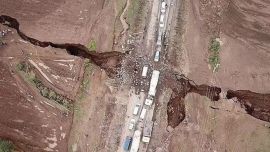Four years ago, back in the offices of the Buenos Aires Herald, I was putting together the newspaper’s frontpage ahead of another edition. This one was to hit the streets on the day of Donald Trump’s inauguration and with 20 minutes to go until print time, I was in trouble.
I’d found a side-on photo of the wotsit-coloured reality TV star that I was happy with. The alleged billionaire was side-on, against an all-black backdrop, looking slightly up with an air of arrogance. It was perfect, but I was struggling with my headline. I’d tried tons of options; the whiteboard scribblings next to me bore testament to that. Time was ticking and I was stuck.
It was hard to find the right tone. It had to be appropriate, yet didn’t appear overly mocking, especially as tens of millions of Americans had voted for a man so repulsive that even his wife couldn’t bring herself to give him a loving glance. And then, just like that, it came to me. I moved the cursor over the page on InDesign, selected the type tool and wrote three simple words: ‘Good luck America.’
It was perfect. The use of ‘good luck’ seemed to encapsulate everything we wanted to say – ‘good luck’ (how are you going to cope with this?!); ‘good luck’ (you’ll need it!); ‘good luck’ (please don’t screw this up); ‘good luck’ (sorry, you’re fucked) – and I was pleased as punch. I sent it off to the printers.
In the days after publication, I started to notice that some US media outlets and users on social media had found the frontpage and were sharing it online. It had hit a nerve, but interestingly enough, people were taking it in different ways. The Trumpanistas were politely thanking the Herald for the warm wishes, while others applauded with likes and retweets, while (virtually) raising their eyebrow along with us.
It had hit a nerve, but interestingly enough, people were taking it in different ways. The Trumpanistas were politely thanking the Herald for the warm wishes, while others applauded with likes and retweets, while (virtually) raising their eyebrow along with us.
If I hadn’t already been sure of the division that existed in the US over their incoming pugnacious president, here was another minor piece of proof staring at me from my screen.
Four years on, the baby-brained buffoon is about to fly back to his basecamp in Florida with his tail between his legs, shamed by a historic second impeachment vote and disowned by many of the very Republicans who enabled him. The departing not-so-dear leader leaves Washington DC in a rare (non-Covid-related) lockdown in a bid to put off potential troublemakers, with the US Capitol as a result resembling something closer to a movie scene than reality.
But of course, Trump won’t go until he has pulled off his final grand tantrum. Unsurprisingly, he will not be present at US President-elect Joe Biden’s inauguration on Wednesday. Some say that’s a disgrace and an affront to the spirit of US democracy (they must have not been watching last week), but in my humble opinion, the sooner he’s out of Washington and away from the nuclear codes the better.
Frankly, who cares where he is after January 20? That’s the beauty of it – we don’t have to.
Many will take Biden’s swearing-in as a chance to look back and assess the United States and where it is today, to see how much the country has been warped by Donald’s wankerous warblings over the last four years. Sure, things have changed – there was no global pandemic beforehand for a start – and there are concerning signs for the road ahead, such as the legitimising of the views of a number of racists, conspiracy theorists and (let’s not beat around the bush) crazy people. But the flip side of this turmoil is that the United States’ institutions did stand up in the face of Trump’s assault.
To put it bluntly, the land is not scorched, though it was certainly shit on.
And so, it’s time to move on. It’s fair to say we will never forget Trump’s time in office, though I have a strong hope that the history books will see him more as an odd paragraph or footnote than a full chapter.
























Comments